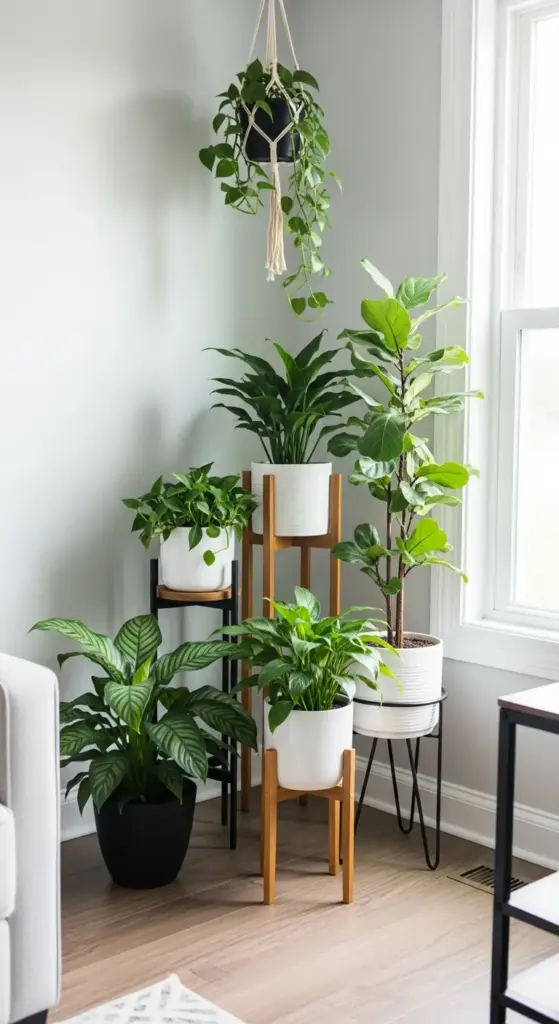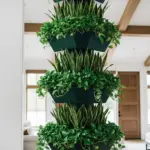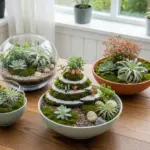5. The Elevation and Platform Strategy

I spent two years wondering why my plant displays looked so amateur compared to the ones I saw on Instagram. Everything was just sitting on the floor like a sad plant parking lot.
Then I realized the secret wasn’t better plants – it was getting them off the ground.
The day I added my first plant stand, everything clicked. Suddenly my space had layers and depth instead of looking flat and boring.
Plant Stands and Risers for Professional Displays
Here’s what nobody tells you about plant stands – they’re not just functional, they’re the secret to making cheap plants look expensive.
Height variation creates what designers call “visual rhythm.” Your eye travels up and down instead of just scanning horizontally across the floor.
I started with one wooden plant stand from Target for $25, and it completely transformed my corner display.
Metal plant stands work great for modern spaces. The thin legs don’t visually clutter your floor space like bulky wooden ones can.
Tiered plant stands let you display multiple plants in the footprint of one. Perfect for small apartments where every square inch counts.
The key is choosing stands that complement your pot styles. Minimalist stands work with any pot design, while ornate ones need careful coordination.
I learned this after buying a fancy wrought-iron stand that completely overwhelmed my simple ceramic pots.
DIY Platform Ideas Using Stuff You Already Own
This is where I got creative because buying multiple plant stands wasn’t in my budget. Turns out, DIY plant risers work just as well as expensive store-bought ones.
Wooden crates flipped upside down make perfect rustic plant platforms. I found mine at a craft store for $8 each.
Stacked books wrapped in decorative paper create instant height. Just make sure they’re books you don’t need anymore – learned that lesson the hard way.
Old wooden stools work amazing as plant stands, especially vintage ones from thrift stores.
Concrete blocks covered with fabric or painted to match your decor look surprisingly modern. Each block costs about $2 at hardware stores.
Storage ottomans pull double duty as plant platforms and hidden storage. Perfect for small spaces where everything needs multiple purposes.
Wooden cutting boards propped on small legs (or even thick books) create sleek platforms for smaller plants.
I made three plant risers for under $20 using materials I already had around the house.
How Elevation Makes Rooms Feel Taller
This was the game-changer I never expected. Vertical plant displays literally trick your brain into thinking your ceilings are higher.
When plants sit only at floor level, your eye stops there. But elevated plants draw your gaze upward, creating the illusion of more vertical space.
I have 8-foot ceilings, but strategic plant elevation makes my living room feel way more spacious.
Hanging plants are the ultimate ceiling-height hack. They fill that awkward upper space that usually just sits empty.
Tall plant stands (36+ inches) work especially well in corners where they don’t interfere with traffic flow.
The layered height effect happens when you have plants at floor level, mid-level (on stands), and upper level (hanging or on tall furniture).
This creates what interior designers call “visual weight distribution” – your eye has interesting things to look at from floor to ceiling.
Safety Considerations for Elevated Plants
Okay, let me share some mistakes I made so you don’t have to learn the hard way. Plant safety becomes crucial once you start elevating everything.
Top-heavy plants on narrow stands are disaster waiting to happen. I knocked over a snake plant twice before learning this lesson.
Always check that your plant stand base is wider than the pot, especially for tall or leafy plants.
Water drainage gets tricky with elevated plants. Drip trays are essential, but make sure they’re big enough to catch overflow.
I ruined a wooden plant stand by not using proper drainage protection. Water stains are not a good look.
Pet considerations became important when my friend’s cat started treating elevated plants like jungle gyms. Stable, wide-based stands are essential with curious pets around.
Child safety means securing tall plant stands to walls if needed. Toddlers love to pull on dangling leaves and can topple unstable displays.
Weight limits matter more than you’d think. That beautiful ceramic pot might be too heavy for a delicate metal stand.
I always test stability by gently pushing on the plant from different angles before leaving it unattended.
Watering access becomes challenging with very tall displays. Make sure you can actually reach your plants for regular care.
Nothing’s worse than beautiful elevated plants that slowly die because they’re too hard to maintain.
The key is finding the sweet spot between dramatic height and practical maintenance.
Ready to discover when splurging on one amazing pot beats buying multiple cheap ones? The next section reveals the “investment pot” checklist and where to find designer-quality containers without designer prices – click below to learn the statement pot strategy!









GIPHY App Key not set. Please check settings